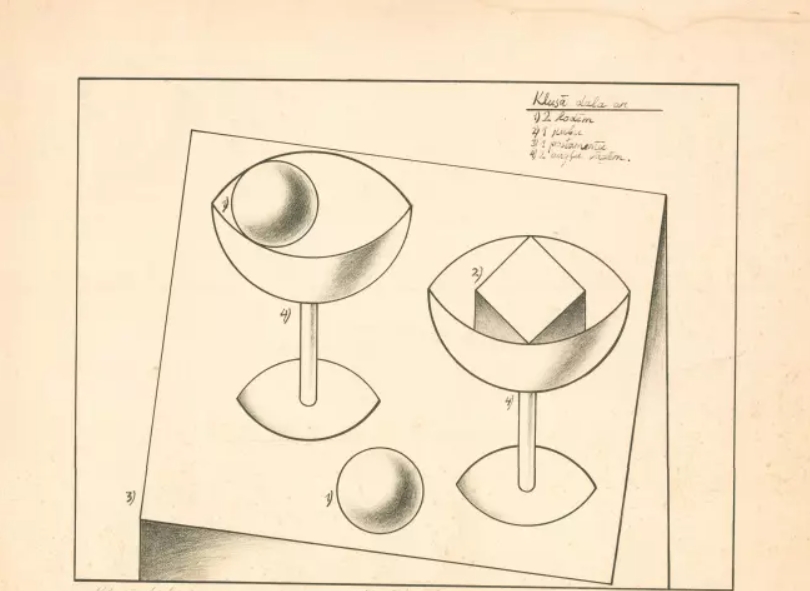Rūsiņš Rozīte entered the art scene effortlessly: started his education, like many, at the Janis Rozentāls Art High School under teacher Edgars Iltners, joined the Art Academy in the Department of Painting, but ended up with graphic artists, at the same time still considering painting to be his priority. Rūsiņš’ passion often exasperated professor Artūrs Apinis, since he often cut his drawings unacademically deep, making the etching plates unusable for a second time. Already during his studies, Rozīte’s clear, laconic style with a concisely expressive, symbolic message had taken shape. In art, Rūsiņš kept his characteristic impulsiveness under control, realising his ideas with maximum precision, since “in order to achieve what is possible one must desire the impossible”.
On the first floor of a darkly-painted house in Vecāķi with a roof sheeted in black tar paper there was an empty room with white walls. This was the defiantly simple rationalism in which the most significant of Rūsiņš’ works were made in the late 1960s – Mathematician’s, Writer’s, Artist’s Still Life, The Drunken Chair, The Black Sun. He spent his summers painting while winter was the time for graphic art.
Still being a last-year student, Rūsiņš responded to his friend, young director Juris Strenga’s invitation to make the stage design for Estonian playwright Mati Unt’s play Kāda būsi, mana pasaule? [What Will You Be, My World?] (1967). For the Dailes Theatre, it was something unusual – a black stage, the white square of the boxing ring, planed chairs from white wood. The actors played in an absolutely minimalist space while the director commented on the proceedings from the auditorium during the performances. Rūsiņš Rozīte was the first stage minimalist. Stage designs for three further plays followed, yet his proposals encountered objections from the artistic council and the resulting compromises provided no satisfaction to either the director or the artist.
Theatricality is also characteristic of Rūsiņš Rozīte’s work in painting and graphic art. At first sight, the image appears clear and unequivocal, but then the curtain to its surreal life is raised. An immaterial presence like vapour envelops objects and living creatures that appear on the stage of Rūsiņš Rozīte’s art.
Geometry is of crucial importance in Rozīte’s works. Endless rows of arches, long walls, straight lines, unfilled fields or meshes from industrial constructions – objects’ multiple appearances across different works are means of conveying a feeling of vastness, solitude and stillness.
The use of reverse perspective in still-life paintings is another element typical of the artist. At the same time, this oddness involves something light and childishly cheerful, making it possible to observe the objects with even greater attention. What is humanly mundane in this symmetrically accurate order approaches the meaning of a sign or symbol. The essence of peace and beauty is what is revealed in the purity of colours and the spatial perfection of the objects’ volumes. Everything is rationally considered and brought to universal stillness. Perhaps that is what melancholy squared in sharp outline could look like.
The exhibition includes works from the collections of the Latvian National Museum of Art, Artists’ Union of Latvia, Zuzāns Collection and several private collections.
Text by Ilze Putniņa
About the exhibition cycle The Generation
Each generation belongs to an era. The Latvian National Museum of Art’s (LNMA) exhibition cycle The Generation began in 2016, focusing on art of the second half of the 20th century. The cycle’s programme is realised in the 4th Floor Exhibition Halls and since 2021 also in the right wing exposition halls on the 2nd floor of the main building of LNMA. The exhibitions devoted to many important figures in Latvian art have been held, such as Boriss Bērziņš, Felicita Pauļuka, Daina Riņķe, Henrijs Klēbahs, Līvija Endzelīna, Hilda Vīka, Gunārs Krollis, Džemma Skulme, Romualds Geikins, Daina Dagnija, Jānis Pauļuks, Māra Kažociņa, Inta Celmiņa, Auseklis Baušķenieks, Gunārs Cīlītis, Jānis Aivars Karlovs, Biruta Baumane, Lea Dāvidova-Medene, Imants Vecozols, Rūsiņš Rozīte. There are exhibitions in preparation for Aija Jurjāne, Rolands Kaņeps, Līga Purmale.
Text by Elita Ansone





